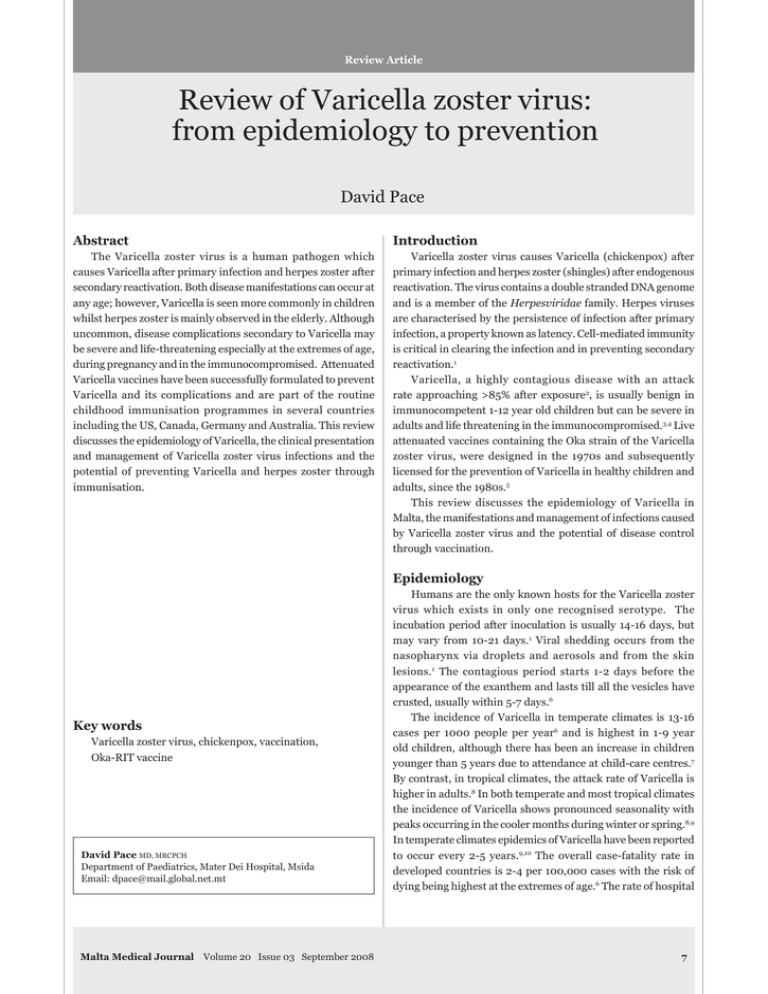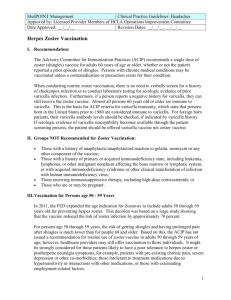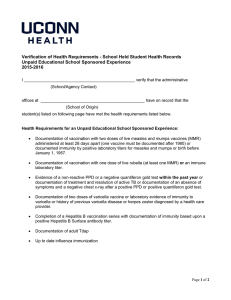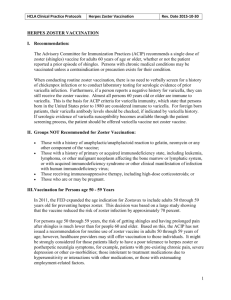Review of Varicella zoster virus: from epidemiology to prevention David Pace Abstract
advertisement

Review Article Review of Varicella zoster virus: from epidemiology to prevention David Pace Abstract Introduction The Varicella zoster virus is a human pathogen which causes Varicella after primary infection and herpes zoster after secondary reactivation. Both disease manifestations can occur at any age; however, Varicella is seen more commonly in children whilst herpes zoster is mainly observed in the elderly. Although uncommon, disease complications secondary to Varicella may be severe and life-threatening especially at the extremes of age, during pregnancy and in the immunocompromised. Attenuated Varicella vaccines have been successfully formulated to prevent Varicella and its complications and are part of the routine childhood immunisation programmes in several countries including the US, Canada, Germany and Australia. This review discusses the epidemiology of Varicella, the clinical presentation and management of Varicella zoster virus infections and the potential of preventing Varicella and herpes zoster through immunisation. Varicella zoster virus causes Varicella (chickenpox) after primary infection and herpes zoster (shingles) after endogenous reactivation. The virus contains a double stranded DNA genome and is a member of the Herpesviridae family. Herpes viruses are characterised by the persistence of infection after primary infection, a property known as latency. Cell-mediated immunity is critical in clearing the infection and in preventing secondary reactivation.1 Varicella, a highly contagious disease with an attack rate approaching >85% after exposure2, is usually benign in immunocompetent 1-12 year old children but can be severe in adults and life threatening in the immunocompromised.3,4 Live attenuated vaccines containing the Oka strain of the Varicella zoster virus, were designed in the 1970s and subsequently licensed for the prevention of Varicella in healthy children and adults, since the 1980s.5 This review discusses the epidemiology of Varicella in Malta, the manifestations and management of infections caused by Varicella zoster virus and the potential of disease control through vaccination. Epidemiology Key words Varicella zoster virus, chickenpox, vaccination, Oka-RIT vaccine David Pace MD, MRCPCH Department of Paediatrics, Mater Dei Hospital, Msida Email: dpace@mail.global.net.mt Malta Medical Journal Volume 20 Issue 03 September 2008 Humans are the only known hosts for the Varicella zoster virus which exists in only one recognised serotype. The incubation period after inoculation is usually 14-16 days, but may vary from 10-21 days.1 Viral shedding occurs from the nasopharynx via droplets and aerosols and from the skin lesions.1 The contagious period starts 1-2 days before the appearance of the exanthem and lasts till all the vesicles have crusted, usually within 5-7 days.6 The incidence of Varicella in temperate climates is 13-16 cases per 1000 people per year6 and is highest in 1-9 year old children, although there has been an increase in children younger than 5 years due to attendance at child-care centres.7 By contrast, in tropical climates, the attack rate of Varicella is higher in adults.8 In both temperate and most tropical climates the incidence of Varicella shows pronounced seasonality with peaks occurring in the cooler months during winter or spring.8,9 In temperate climates epidemics of Varicella have been reported to occur every 2-5 years.9,10 The overall case-fatality rate in developed countries is 2-4 per 100,000 cases with the risk of dying being highest at the extremes of age.6 The rate of hospital admission for all ages is 2–6 per 100,000 population with most admissions occurring in children.6,11 In contrast to other European countries, notification of Varicella in Malta is mandatory. The number of notified cases over the last 30 years varied from year to year12 reflecting the natural cycles of Varicella as well as differences in case ascertainment and reporting (Figure 1). The average incidence of Varicella in Malta (from 1999 – 2005) was 9/10,000 population per year. By comparison the burden of Varicella in other countries was reported to be 25 per 10,000 in England and Wales, 13 per 10,000 in The Netherlands, and 21 per 10,000 in Portugal.13 Such differences could be explained by variability in surveillance, health care systems and completeness of ascertainment between countries.6 A formulation of the Varicella zoster virus vaccine was introduced on the private market in Malta in 1998. Presently local uptake rates of this vaccine are unknown as such data are not being collected. No adverse drug reactions (ADRs) associated with the administration of this Varicella vaccine formulation have been reported to the Medicines Authority since the set up of the ADR database in 2004. Analysis of the number of notified cases after 1998 does not show the expected decline in the disease burden of Varicella over the subsequent years. This is because control and elimination of the disease is dependent on the ability to vaccinate a herd immune threshold the size of which can be determined by mathematical modelling, as has been calculated for those countries taking part in the European sero-epidemiology network 2 (ESEN2) project which collected serological surveillance data on vaccine preventable diseases, including Varicella.14 Clinical manifestations Varicella is characterised by the appearance of a generalised pruritic vesicular rash, typically consisting of 250–500 lesions, associated with constitutional symptoms including headache, malaise, loss of appetite and mild fever. Lesions, which typically appear in crops, are more concentrated centrally, on the trunk and face, than on the limbs. The crusts which form on the healing lesions fall off after 1-2 weeks and frequently leave areas of hypo- or hyperpigmentation, which may persist for months, or permanent scars15. Complications include bacterial superinfection of the skin lesions, which are frequently caused by Group A streptococcus and seen in >5% of children, arthritis, osteomyelitis, thrombocytopenia, pneumonitis, hepatitis and central nervous system manifestations including cerebellar ataxia, meningoencephalitis and intracranial vasculitis.16 Pneumonia is more often seen in adults and during pregnancy.3,16 Immunocompromised children have an increased risk of developing progressive severe Varicella with visceral dissemination.17 Following a period of latency in the dorsal root ganglia, reactivation results in herpes zoster, characterised by the appearance of vesicles in a dermatomal distribution. The incidence of herpes zoster is 74 ��������������������������������� per 100,000 in children below Figure 1: Number of notified cases of Varicella in Malta (1978 – 2007) Malta Medical Journal Volume 20 Issue 03 September 2008 the age of 10 years but reaches up to 1200 per 100,000 in people >75 years, who are at an increased risk of postherpetic neuralgia.18 Severe herpes zoster, affecting an unusual site, or appearing in a multi-dermatomal distribution and with a potential for visceral involvement, may occur in individuals who are immunocompromised such as those receiving chemotherapy, especially those with leukaemia, those on high dose steroids and in patients with the Acquired Immunodeficiency syndrome (AIDS).1,19 Maternal Varicella in the first 20 weeks of pregnancy results in Varicella embryopathy in 2% of the fetuses.20 The congenital Varicella syndrome is characterised by limb atrophy, scarring of the skin of the extremities, chorioretinitis, cataracts and brain abnormalities which are associated with developmental delay and a poor outlook.20 Maternal Varicella developing 5 days before to 2 days following delivery may result in severe neonatal Varicella which has a mortality rate of 30%.21 Diagnosis Diagnosis is usually established clinically from the characteristic rash which is easily differentiated from that of small pox from the typical stages of development of the skin lesions. Varicella–zoster specific IgM may be detectable as early as 1-2 days before the appearance of the rash, although the absence of antibodies does not rule out the diagnosis.6 IgG antibodies appear shortly after the IgM response and persist throughout lifetime6. For fatal, severe or atypical illness the Varicella zoster virus may be identified from skin scrapings by PCR22 or by immunofluorescence techniques.23 Treatment In the majority of cases Varicella in immunocompetent children is a self-limiting disease and symptomatic treatment, which includes temperature control, alleviation of pruritus and adequate hydration, is usually sufficient. Non-steroidal antiinflammatory drugs are not recommended for symptomatic relief due to the possible associated increased risk of invasive Streptococcus pyogenes infections.24 The administration of antibiotics is necessary when treating secondary bacterial infections. Antivirals, such as acyclovir, are mandatory for high risk individuals, including immunocompromised hosts and newborns with transplacentally-acquired Varicella, and in those with Varicella mediated complications, such as pneumonia and encephalitis. Prevention Passive immunoprophylaxis Varicella-susceptible individuals, who are at a high risk of developing severe or disseminated Varicella, may be given human Varicella zoster immunoglobulin (VZIG) after a significant exposure to the virus. Susceptible high risk individuals include the immunocompromised, non-immune pregnant women and newborn infants exposed to maternal varicella1. Malta Medical Journal Volume 20 Issue 03 September 2008 Active immunisation An attenuated Varicella zoster vaccine was developed from an Oka strain of the wild type Varicella zoster virus in Japan in 1974 by Takahashi and colleagues.25 Subsequently this vaccine master seed was licensed out to various manufacturers and currently there are three preparations of the Oka strain Varicella zoster virus vaccine in use: OkavaxTM, manufactured by the Research Foundation for Microbial Diseases of Osaka University (BIKEN) in Osaka, Japan (distributed by Sanofi Pasteur, Lyon, France), VarivaxTM (Merck & Co., Inc., Whitehouse Station, New Jersey, USA), and VarilrixTM (GlaxoSmithKline Biologicals, Rixensart, Belgium). Both VarivaxTM and VarilrixTM are licensed in Europe for use from the age of 12 months, with VarilrixTM being licensed from the age of 9 months in some countries. Since VarilrixTM is currently the only Varicella zoster virus vaccine marketed in Malta, only data from clinical trials which investigated this vaccine will be discussed. VarilrixTM will be referred to as the Oka-recombinant immunotoxin (Oka-RIT) vaccine for the purpose of this article. Immunogenicity The administration of a single subcutaneous dose of the Oka-RIT vaccine, which contains a minimum of 1995 plaque forming units (PFU) of the Oka-vaccine strain, in 12 month to 12 year old children results in a seroconversion rate >98%, using a glycoprotein Enzyme-linked Immunosorbent Assay (gpELISA).26 Post immunisation Varicella zoster antibodies persist for at least up to 7 years in children vaccinated at 12–15 months of age.26 In June 2006, the US Advisory Committee on Immunization Practices (ACIP) recommended two doses of a similar Oka-strain (Oka/Merck) vaccine, VarivaxTM, in children <13 years of age since, as despite an efficacy rate of 85%, a single dose was not enough to prevent outbreaks of breakthrough Varicella (i.e. Varicella occurring in previously vaccinated individuals).27 Such a recommendation might not be applicable to countries without a universal Varicella vaccination programme as ongoing exposure to wild-type virus might result in natural boosting of cellular immunity and a subsequent longer duration of protection.28 In adolescents ≥13 years and in adults, a two-dose schedule of the Oka-RIT vaccine at an interval of 6-10 weeks, results in a seroconversion rate of 100% after the second dose.26 The Oka-RIT vaccine may be safely administered concurrently, but at a different site, with the combined measles, mumps and rubella (MMR) vaccine as studies have shown that there is no compromise of the immunogenicities of any of the four vaccine antigens with simultaneous administration of these vaccines.26 Quadrivalent vaccine formulations incorporating the measles, mumps, rubella and Varicella (MMRV) attenuated viruses have been recently licensed for use in children. Currently there are two licensed MMRV vaccine preparations: ProQuadTM (Merck & Co., Whitehouse station, New Jersey, USA) licensed from the age of 12 months to 12 years in the US and Priorix TetraTM (GlaxoSmithKline Biologicals, Rixensart, Belgium) licensed in Germany and Australia for immunisation of 1-2 year old children. A higher dose of the Oka-strain Varicella virus had to be incorporated in both combination vaccine formulations in order to achieve an immune response comparable to that induced by the monovalent Varicella vaccines. Vaccine use In 2004, the European Working Group on Varicella (EuroVar) recommended Varicella vaccination for all healthy 12-18 month old children and all susceptible children <13 years, in addition to the routine vaccination of susceptible children ≥13 years old and adults.29 Pre-exposure vaccination is advisable in susceptible healthcare workers, laboratory staff and contacts of immunocompromised individuals.29 When administered within 96 hours from exposure, the Oka-RIT vaccine is 80-90% effective in preventing moderate to severe disease in Varicella naïve individuals.26 Post-exposure prophylaxis is possible since, the Oka vaccine strain induces an immune response prior the clinical viraemia with the wild type virus and thus helps to abort or modify clinical disease. There are currently no data on the impact of the Varicella vaccination on the incidence of herpes zoster several decades after vaccination. However a high dose Oka-strain virus vaccine (ZostavaxTM, Merck & Co. Inc., Whitehouse Station, New Jersey, USA) has been shown to reduce the incidence and morbidity from herpes zoster and postherpetic neuralgia in elderly people.30 Vaccination with the Oka-RIT vaccine is contraindicated in individuals with hypersensitivity to any of the vaccine constituents, during pregnancy and lactation, whilst on high dose systemic corticosteroids (amounting to >1mg/kg/day of prednisolone or its equivalent or 20mg/day if weight is >20kg) and in the immunocompromised, although the vaccine may be given with caution and under expert supervision in children with specific immunodeficiencies, such as in acute lymphoblastic leukaemia in stable remission for 12 months.26 Following vaccination the use of salicylates in children and adolescents <16 years is not recommended because of the theoretical risk of Reye’s syndrome.31 Adverse events Erythema, swelling and pain at the injection site are the most frequently reported local side effects, occurring in 10%20% of vaccinees ≤12 years.26 Constitutional symptoms such as headache, fever and fatigue are also common. Rashes occur in 5% of vaccinees. Transmission of the vaccine virus following the appearance of a vesicular rash post immunisation was documented in only 3 individuals (who developed mild disease) after the administration of >30 million doses of the Oka/Merck vaccine used in the US.27 Vaccinees who develop a vesicular rash should however avoid contact with high risk individuals. The rate of febrile convulsions of 9/10,000 reported in 12-23 month old children, 7-10 days after receiving the combination 10 MMRV formulation (ProQuadTM), has recently been identified to be higher than the rate of 4/10,000 observed in children immunised with the separate MMR and Varicella vaccine formulations.32 Because of this post-licensure surveillance data the US ACIP does not prefer the use of MMRV over separate injections of MMR and Varicella, any more.32 However both the MMRV and the separate MMR and Varicella vaccine formulations may still be used for immunising children. Conclusion and future directions The disease burden of the Varicella zoster virus in countries without a universal Varicella vaccination schedule is high, with most episodes of hospitalisation, due to serious and potentially life-threatening and debilitating complications, occurring in healthy children. Safe and effective Varicella zoster vaccines are currently licensed in several countries for the prevention of Varicella from late infancy to adulthood and may be safely administered concurrently with other vaccines which are already part of the childhood immunisation schedule. The Varicella zoster vaccine already forms part of the national childhood vaccination programmes in Austria, Cyprus, Germany, Italy, Spain, Switzerland33, the US, Canada and Australia, however, economic issues will have a major bearing on the introduction of a ‘free of charge’ Varicella vaccine in the national childhood immunisation programme in Malta. Immunising all children against Varicella would ultimately result in control of the spread of the disease, protection of high risk susceptible patients through herd immunity, a reduction in the cost of treating patients with Varicella and its complications and a decrease in societal costs from parents taking time off work to care for their children infected with Varicella. Following on from the occurrence of breakthrough Varicella after a single dose of the Varicella vaccine in children in the US, the introduction of routine Varicella vaccination for all healthy Maltese children and adolescents might eventually need to be followed by a booster dose to counteract the lack of natural boosting from wild-type Varicella. Surveillance of the Varicella vaccine uptake in Malta would be crucial in assessing the impact this vaccine would have on the disease burden of Varicella. In addition, the availability of a herpes zoster vaccine to prevent or modify herpes zoster and its complications in adults aged 60 years or older, would further aid in reducing the morbidity caused by the Varicella zoster virus. Acknowledgments The author would like to thank Dr Charmaine Gauci, Dr Gianfranco Spiteri and Mr Peter Grech, all from the Disease Surveillance Unit, Malta, for providing data on Varicella notification. In addition the author thanks Dr Victoria Farrugia Sant’Angelo from the Primary Health Care Department, Malta for providing information on the uptake of the Varicella vaccine, Ms Suzanne Mifsud and Dr John J. Borg, both from the Medicines Authority, Malta for providing data on adverse drug Malta Medical Journal Volume 20 Issue 03 September 2008 reactions reported following the use of the Varicella vaccine and Mr Shawn S. Borg, from the National Statistics Office, Malta, for providing the data on the population size which were used to work out the local incidence rates of Varicella. References 1. Arvin AM. Varicella zoster virus. Clin Microbiol Rev. 1996; 9:361-81. 2. Hope–Simpson RE. Infectiousness of communicable diseases in the household (measles, chickenpox and mumps). Lancet. 1952;2:549–54. 3. Preblud SR. Age-specific risks of Varicella complications. Pediatrics. 1981;68:14-7. 4. Preblud SR. Varicella: complications and costs. Pediatrics. 1986;78:728-35. 5. Clements DA. Varicella vaccination in children. BioDrugs. 2000;14:49-60. 6. Heininger U, Seward JF. Varicella. Lancet. 2006;368:1365-76. 7. Ross AM, Fleming DM. Chickenpox increasingly affects preschool children. Commun Dis Public Health. 2000;3:213-5. 8. Lee BW. Review of Varicella zoster seroepidemiology in India and Southeast Asia. Trop Med Int Health. 1998;3:886-90. 9. Bramley JC, Jones IG. Epidemiology of chickenpox in Scotland: 1981 to 1998. Commun Dis Public Health. 2000;3:282-7. 10.Deguen S, Chau NP, Flahault A. Epidemiology of chickenpox in France (1991-1995). J Epidemiol Community Health. 1998;52 Suppl 1:46S-9S. 11. Wharton M. The epidemiology of Varicella zoster virus infections. Infect Dis Clin North Am. 1996;10:571-81. 12.Disease Surveillance Unit, Department of Public Health, Ministry of Health, the Elderly and Community Care, Government of Malta. Annual Reports: 2001-2005 (and personal communication). Available from: http://www.health.gov.mt/dsu/ reports/index.htm. Accessed 6th July 2008 13.Fleming DM, Schellevis FG, Falcao I, Alonso TV, Padilla ML. The incidence of chickenpox in the community. Lessons for disease surveillance in sentinel practice networks. Eur J Epidemiol. 2001;17:1023-7. 14.Nardone A, de Ory F, Carton M, Cohen D, van Damme P, Davidkin I, et al. The comparative sero-epidemiology of Varicella zoster virus in 11 countries in the European region. Vaccine. 2007;25:7866-72. 15.Leung AK, Kao CP, Sauve RS. Scarring resulting from chickenpox. Pediatr Dermatol. 2001;18:378-80. 16.Bricks LF, Sato HK, Oselka GW. Varicella vaccines and measles, mumps, rubella, and Varicella vaccine. J������������������� Pediatr (Rio J). 2006;82(3 Suppl):S101-8. 17.Feldman S, Hughes WT, Daniel CB. Varicella in children with cancer: Seventy-seven cases. Pediatrics. 1975;56:388-97. 18.Skull SA, Wang EE. Varicella vaccination--a critical review of the evidence. Arch Dis Child. 2001;85:83-90. Malta Medical Journal Volume 20 Issue 03 September 2008 19.Leung AK, Robson WL, Leong AG. Herpes zoster in childhood. J Pediatr Health Care. 2006;20:300-3. 20.Enders G, Miller E, Cradock-Watson J, Bolley I, Ridehalgh M. Consequences of Varicella and herpes zoster in pregnancy: prospective study of 1739 cases. Lancet. 1994;343:1548-51. 21.Nathwani D, Maclean A, Conway S, Carrington D. Varicella infections in pregnancy and the newborn. A review prepared for the UK Advisory Group on Chickenpox on behalf of the British Society for the Study of Infection. J Infect. 1998;36 Suppl 1:59-71. 22.Kido S, Ozaki T, Asada H, Higashi K, Kondo K, Hayakawa Y, et al. Detection of Varicella zoster virus (VZV) DNA in clinical samples from patients with VZV by the polymerase chain reaction. J Clin Microbiol. 1991;29:76-9. 23.Loparev VN, McCaustland K, Holloway BP, Krause PR, Takayama M, Schmid DS. Rapid genotyping of Varicella zoster virus vaccine and wild-type strains with fluorophore-labeled hybridization probes. J Clin Microbiol. 2000;38:4315-9. 24.Lesko SM, O’Brien KL, Schwartz B, Vezina R, Mitchell AA. Invasive group A streptococcal infection and nonsteroidal antiinflammatory drug use among children with primary Varicella. Pediatrics. 2001;107:1108-15. 25.Takahashi M, Otsuka T, Okuno Y, Asano Y, Yazaki T. Live vaccine used to prevent the spread of Varicella in children in hospital. Lancet. 1974;2:1288-90. 26.Chiu SS, Lau YL. Review of the Varilrix Varicella vaccine. Expert Rev Vaccines. 2005;4:629-43. 27.Marin M, Güris D, Chaves SS, Schmid S, Seward JF; Advisory Committee on Immunization Practices, Centers for Disease Control and Prevention (CDC). Prevention of Varicella: recommendations of the Advisory Committee on Immunization Practices (ACIP). MMWR Recomm Rep. 2007;56(RR-4):1-40. 28.Asano Y, Suga S, Yoshikawa T, Kobayashi I, Yazaki T, Shibata M, et al. Experience and reason: twenty-year follow-up of protective immunity of the Oka strain live Varicella vaccine. Pediatrics. 1994;94:524-6. 29.Rentier B, Gershon AA; European Working Group on Varicella. Consensus: Varicella vaccination of healthy children--a challenge for Europe. Pediatr Infect Dis J. 2004;23:379-89. 30.Oxman MN, Levin MJ, Johnson GR, Schmader KE, Straus SE, Gelb LD, et al. A vaccine to prevent herpes zoster and postherpetic neuralgia in older adults. N Engl J Med. 2005;352:2271-84. 31.Starko KM, Ray CG, Dominguez LB, Stromberg WL, Woodall DF. Reye’s syndrome and salicylate use. Pediatrics. 1980;66:859–64. 32.Centers for Disease Control and Prevention (CDC); Advisory Committee on Immunization Practices (ACIP). Update: recommendations from the Advisory Committee on Immunization Practices (ACIP) regarding administration of combination MMRV vaccine. MMWR Morb Mortal Wkly Rep. 2008;57:258-60. 33.EUVAC. A surveillance community network for vaccine preventable infectious diseases. Varicella vaccination overview in European countries. Available from http://www.euvac.net. Accessed 5th July 2008. 11


